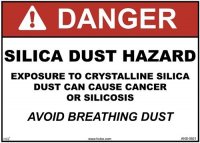Protect miners from silica dust exposure

Summary of the issue
Rates of Black Lung disease have hit a 25-year high in Appalachian coal mining states and there is increasing evidence that exposure to silica dust is driving this resurgence, particularly in regard to the most severe form of the disease.
The Mine Act under which the Mine Safety and Health Administration (MSHA) operates requires the agency to regulate dust so that “no miner will suffer material impairment of health or functional capacity,” even if that miner were to spend his/her entire working life in the mines. In 1995 the National Institute for Occupational Safety and Health (NIOSH) looked at MSHA's 2.0 mg/m³ coal dust standard and determined that it was not sufficiently protective of miners and that the level should be reduced by half. NIOSH also found that crystalline silica constituted a particular lung hazard to coal miners and recommended that the exposure limit be reduced from 100µg/m³ to 50µg/m³.
In 2014, MSHA reduced the coal dust standard from 2.0 to 1.5mg/m³. Though the 2014 coal dust rule was some progress, the silica standard for miners has not been updated since 1985. MSHA commenced a rulemaking process for a separate silica standard, but it was not completed. In spring 2016, the silica standard was listed as a “proposed rule” on the agency's rule list. However, in the spring 2019 list, the silica standard was no longer listed as a “proposed rule,” but as in the "pre-rule stage" – the earliest stage of a rulemaking process.
In the years since MSHA received those formal recommendations from NIOSH, miners have continued to get Black Lung. Recent studies by NIOSH show alarming increases in the incidence of Black Lung and the rate of miners being diagnosed with the most severe form of the disease – Progressive Massive Fibrosis (PMF) – is the highest ever recorded. In addition, those miners diagnosed with PMF are often younger and have fewer years of mining experience and exposure than those that have been afflicted by PMF prior to this recent resurgence.
We need protection for our miners. Let's put our voices together for people who no longer have breath. Help us tell MSHA that we need a stronger silica standard for our miners.
Take Action Now
Here are some things you can do to take action right now.
-
Submit a comment to MSHA by October 28, 2019. Identify that you are writing in response to Docket no. MSHA-2016-0013 and:
-
Write an email to [email protected] or [email protected] using these suggested talking points
-
Write a letter using these suggested talking points to: MSHA, Office of Standards, Regulations, and Variances, 201 12th Street South, Suite 4E401, Arlington, Virginia 22202-5452.
-
Submit a comment through the online portal
-
Write your own using these suggested talking points
-
Submit this draft comment
-
Attend the public hearing in Arlington on October 17, 2019. More information can be found here.
Suggested Talking Points
-
MSHA should create a stricter, separately enforceable silica dust standard.
In 1995 and 1996 the National Institute of Occupational Safety and Health (NIOSH) suggested a reduced standard from 100 to 50µg/m3. In 2016 the Occupational Safety and Health Administration (OSHA) established a reduced silica standard that matches the NIOSH recommendation and allows exposure to a concentration of 50µg/m³ of silica over an eight-hour shift. OSHA found that a revised exposure limit of 50µg/m3 substantially reduces worker risk of silicosis mortality. An exposure limit of 100 µg/m3 per shift is not sufficient for protecting miner health.
-
MSHA should improve enforcement of engineering, administrative and environmental controls which includes better practices for validating whether or not samples are representative of daily dust conditions. Recent studies (Doney et al., 2019) indicate that, though dust levels are generally decreasing over the last four decades, the average percentage of quarts in dust samples as exceeded 5% - the percentage at which MSHA is required to reduce the overall dust standard for a mine - in Central Appalachia. And, it is very likely that many miners are actually exposed to even higher concentrations of dust than those reported by sampling. In interviews with miners, researchers and investigative journalists have found that dust ventilation plans are followed more closely and production diminished when MSHA inspectors are in the mines..
-
MSHA should not place the burden of self-protection on miners and their access to respirators. The air of the environment in which the miners work should be made safe as it is often difficult or even impossible to wear respiratory equipment in the mines.
During the June 2019 hearing in front of the House Education and Labor Committee’s Workforce Protections Subcommittee the leader of MSHA, David Zatezalo, said that MSHA’s RFI for silica would be focused on exploring the use of personal protective equipment and respirators in order to protect miners. At the same hearing, Cecil Roberts, president of the UMWA, testified that there are situations in which it is almost impossible or very difficult to wear any kind of respirator or personal protective equipment in the mines. In addition, as stated by Reynolds et al. (2018), “In general, using personal protective equipment (PPE) such as respirators is the least preferred method to control hazardous occupational exposures. To reliably reduce exposures, the correct type of respirator must be worn at the correct time and must fit and function properly. Breakdowns can occur with any of these steps. This is why engineering controls to reduce respirable dust exposures to safe levels are preferred,” (p. 9).
Here are some additional resources on the issue
-
ACLC Blog post: http://www.blacklungblog.com/2019/10/silica-dust-and-complicated-black-lung-disease-how-long-before-miners-are-protected/
-
News articles:
-
Short documentary: https://www.pbs.org/wgbh/frontline/podcast/dispatch/struggling-for-breath-in-coal-country/
-
UMWA: http://umwa.org/news-media/news/union-leaders-call-for-new-msha-silica-standard
- Home
- |
- Sitemap
- |
- Get Involved
- |
- Privacy Policy
- |
- Press
- |
- About
- |
- Bill Tracker
- |
- Contact
- |
- Links
- |
- RSS

